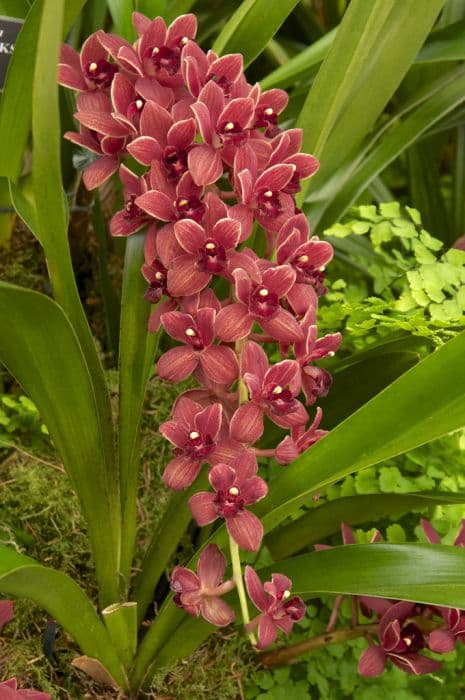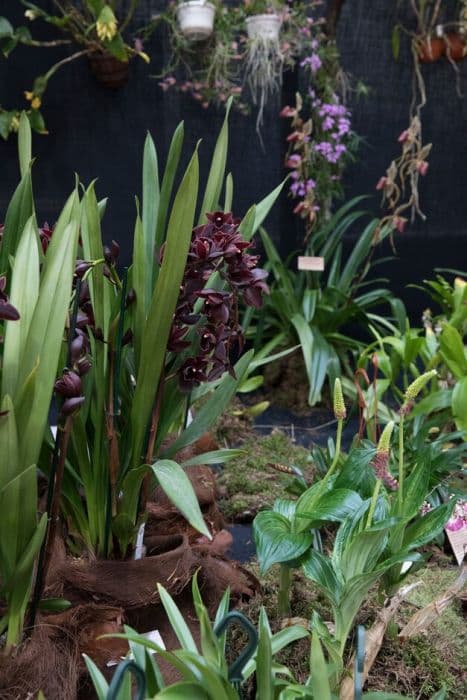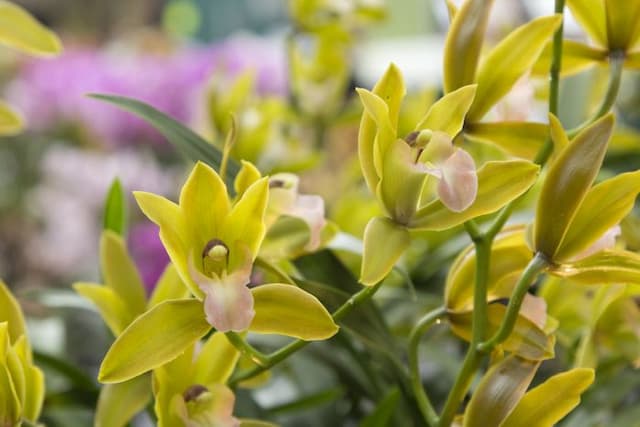Dendrobium Berry Oda Dendrobium Berry gx

ABOUT
The Dendrobium Berry is an orchid known for its enchanting appearance, which captures attention with its delightful flowers. As one of the numerous varieties in the Dendrobium family, this particular type blooms with an impressive display of color and form. The flowers typically present a striking contrast in hues, featuring petals that may exhibit shades of pink, purple, or sometimes a berry-like color, hence the name Berry in its title. The blooms are known for their long-lasting nature and can create a stunning display that is both vibrant and captivating. These flowers emerge from canes that are slender and sometimes slightly curved, adding an elegant structure to the plant's overall form. The leaves of the Dendrobium Berry are equally graceful; they are narrow and pointed, with a glossy green surface that complements the brilliance of the blossoms. The foliage provides a lush backdrop for the flowers, enhancing their visual impact. This orchid's allure is further magnified by its floral arrangement. The blossoms are often grouped in clusters along the stem, which creates a sumptuous bouquet effect. The individual flowers are meticulously designed by nature, featuring a symmetrical arrangement of petals and a delicate lip that is typically a different color, adding depth and complexity to their appearance. Orchid enthusiasts cherish the Dendrobium Berry for its ornamental value, as it brings a touch of exotic beauty to any setting. Whether perched in pots, hanging baskets, or displayed in a conservatory, this plant is a testament to the diversity and splendor of the orchid family. Its ability to bloom under various conditions makes it a popular choice for both novices and experts in the world of horticulture.
About this plant
 Names
NamesFamily
Orchidaceae.
Synonyms
Dendrobium Berry Oda.
Common names
Dendrobium Berry gx.
 Toxicity
ToxicityTo humans
The Dendrobium Berry, commonly known as the Dendrobium orchid, is not toxic to humans. These orchids are generally considered safe and there are no known toxic effects from ingesting parts of this plant. Therefore, no symptoms of poisoning are expected to occur from contact with or ingestion of Dendrobium orchids.
To pets
The Dendrobium orchid is considered non-toxic to pets as well. It is not known to cause poisoning in household pets such as cats and dogs. Ingesting parts of a Dendrobium orchid should not result in any toxic effects or symptoms of poisoning for pets. However, it's always a good practice to monitor your pets around plants, as individual animals may have different sensitivities or allergic reactions.
 Characteristics
CharacteristicsLife cycle
Perennials
Foliage type
Evergreen
Color of leaves
Green
Flower color
Pink
Height
1-2 feet (30-60 cm)
Spread
1 foot (30 cm)
Plant type
Orchid
Hardiness zones
9
Native area
Asia
Benefits
 General Benefits
General Benefits- Ornamental appeal: Dendrobium Berry, known for its beautiful and long-lasting flowers, adds aesthetic value to home and garden spaces.
- Easy to care for: This orchid is relatively easy to maintain, making it a good choice for both novice and experienced gardeners.
- Long blooming period: The Dendrobium Berry often has a prolonged flowering season, providing color and interest for an extended time.
- Gift potential: Due to its appealing look and ease of care, the plant is a popular choice as a gift for plant enthusiasts and on special occasions.
- Adaptability: It can adapt to a variety of indoor environments, which allows it to thrive in many home settings.
- Symbolism and cultural significance: Orchids have various symbolic meanings, including love, beauty, and strength, and can be pertinent to different cultures.
- Therapeutic hobby: Gardening and taking care of plants like the Dendrobium Berry can be a soothing and therapeutic hobby, contributing to stress reduction and mental well-being.
 Medical Properties
Medical Properties- This plant is not used for medical purposes.
 Air-purifying Qualities
Air-purifying QualitiesThis plant is not specifically known for air purifying qualities.
 Other Uses
Other Uses- The Orchid can be used as a natural dye source for fabrics, imparting a range of subtle colors depending on the processing method used.
- In some cultures, Orchids like Dendrobium are used in wedding ceremonies and are woven into bridal bouquets or headpieces due to their beauty and perceived symbolism of fertility and love.
- They are sometimes used in food presentation for high-end cuisine restaurants, as an edible decoration due to their non-toxic nature and exotic appearance.
- Orchid plants are used as a biological learning tool in classrooms to teach students about pollination and the life cycle of plants.
- The long-lasting blooms are used in the fashion industry, where they might adorn hats, headbands, or accessories for runway shows.
- They can be used in art installations and floral sculptures, taking advantage of their unique shapes and vibrant colors to create living art pieces.
- Photographers often use Orchids like the Dendrobium as subjects or backdrops in portrait photography, enhancing the aesthetic appeal of the photos.
- Orchid enthusiasts may use specific species in competitive horticulture, striving to grow prize-winning specimens for orchid shows.
- The stem of the Orchid is sometimes used in the creation of perfumes, although not as commonly as other botanical ingredients.
- Due to their delicate and intricate nature, Orchids are used as inspiration in design fields, including jewelry, textiles, and even architectural elements.
Interesting Facts
 Feng Shui
Feng ShuiThe Dendrobium orchid is not used in Feng Shui practice.
 Zodiac Sign Compitability
Zodiac Sign CompitabilityThe Dendrobium orchid is not used in astrology practice.
 Plant Symbolism
Plant Symbolism- Resilience: Dendrobium orchids are known for their hardiness and ability to adapt to various environmental conditions, symbolizing resilience and the ability to endure challenges.
- Fertility: With their prolific blooming nature, these orchids are often associated with fertility and abundance.
- Beauty: The striking appearance of Dendrobium orchids represents beauty and refinement, often used to convey elegance.
- New Beginnings: Orchids in general can signify new beginnings or rebirth, making them fitting gifts for celebratory occasions.
- Purity: The delicate and pristine blooms of the Dendrobium orchid may symbolize purity and innocence.
- Love: Given as gifts, orchids can represent love and affection towards the recipient.
 Water
WaterThe Dendrobium Berry, commonly referred to as Dendrobium Orchid, should be watered once a week, allowing the potting medium to nearly dry out between waterings. When watering, use room temperature water and thoroughly saturate the potting medium until water runs freely from the bottom of the pot. This usually requires about 16 to 24 ounces depending on the size of the pot. During the winter rest period, reduce watering to bi-weekly or enough to prevent the medium from completely drying out.
 Light
LightDendrobium Orchids thrive in bright but indirect light. Position them in an east- or west-facing window where they receive morning or late afternoon sunlight. Avoid placing your orchid in direct midday sun, which can scorch its leaves, but ensure it gets ample light to encourage flowering.
 Temperature
TemperatureDendrobium Orchids prefer temperatures between 50-70 degrees Fahrenheit at night and 65-85 degrees during the day. They can withstand short periods of high temperatures up to 95 degrees but should not be subjected to temperatures below 50 degrees for extended periods.
 Pruning
PruningPrune Dendrobium Orchids to remove any dead or damaged blooms and canes to maintain the plant's health and appearance. Pruning should be done after flowering, usually in the autumn. This encourages the plant to rest and gather energy for the next blooming season.
 Cleaning
CleaningAs needed
 Soil
SoilFor Dendrobium Berry Oda (Dendrobium Berry gx), a suitable soil mix consists of medium bark pieces, charcoal, and perlite to provide excellent drainage and aeration. The orchid thrives in slightly acidic to neutral pH, ranging from 5.5 to 7.0.
 Repotting
RepottingDendrobium Berry Oda should be repotted every 2 to 3 years or when the potting medium starts to decompose, which can vary depending on the environment. Ensure the new pot has adequate drainage.
 Humidity & Misting
Humidity & MistingDendrobium Berry Oda prefers high humidity levels, around 50-70%, to flourish. A humidity tray or a room humidifier can help maintain these conditions.
 Suitable locations
Suitable locationsIndoor
Place in bright, indirect light and provide high humidity for Dendrobium Berry Oda.
Outdoor
Grow in dappled light, shelter from extreme weather for Dendrobium Berry Oda.
Hardiness zone
9-11 USDA
 Life cycle
Life cycleThe Dendrobium Berry 'Oda', a hybrid orchid, starts its life cycle when a seed germinates, typically in a symbiotic relationship with a fungus which aids in nutrient absorption. As it grows, the plant develops a pseudobulb, a storage organ, from which leaves emerge. The roots, which are also important for water and nutrient uptake, extend into the growing medium. During the vegetative stage, the plant grows and produces new shoots, leading to clumps of pseudobulbs. The flowering stage comes next, where blossoms emerge from the nodes along the stem and can last several weeks. After pollination and subsequent fertilization, the plant can produce seed pods, thereby enabling the cycle to begin anew with seed dispersal and germination.
 Propogation
PropogationPropogation time
Spring-Early Summer
Propogation: The most popular method of propagating the Dendrobium Berry orchid, also known simply as Dendrobium, is through keiki development, which occurs naturally on the mother plant. Keikis are baby plants that form on a node along the flowering stem. After the Dendrobium has finished blooming, it might produce these offshoots, which can be encouraged by applying a keiki paste containing cytokinins to the nodes. Once the keiki has developed several roots at least an inch (approximately 2.54 centimeters) long, it can be gently removed and potted in a small container with an appropriate orchid medium. It's important to maintain a high humidity and warm temperature to encourage the keiki to establish in its new pot.









